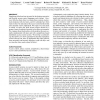Free Online Productivity Tools
i2Speak
i2Symbol
i2OCR
iTex2Img
iWeb2Print
iWeb2Shot
i2Type
iPdf2Split
iPdf2Merge
i2Bopomofo
i2Arabic
i2Style
i2Image
i2PDF
iLatex2Rtf
Sci2ools
CHI
2008
ACM
2008
ACM
A user study of policy creation in a flexible access-control system
Significant effort has been invested in developing expressive and flexible access-control languages and systems. However, little has been done to evaluate these systems in practical situations with real users, and few attempts have been made to discover and analyze the access-control policies that users actually want to implement. We report on a user study in which we derive the ideal access policies desired by a group of users for physical security in an office environment. We compare these ideal policies to the policies the users actually implemented with keys and with a smartphone-based distributed access-control system. We develop a methodology that allows us to show quantitatively that the smartphone system allowed our users to implement their ideal policies more accurately and securely than they could with keys, and we describe where each system fell short. Author Keywords Access control, policy creation, smartphones, discretionary access control, distributed access control. ACM...
CHI 2008 | Human Computer Interaction | Ideal Access Policies | Ideal Policies | Keywords Access Control |
| Added | 30 Nov 2009 |
| Updated | 30 Nov 2009 |
| Type | Conference |
| Year | 2008 |
| Where | CHI |
| Authors | Lujo Bauer, Lorrie Faith Cranor, Robert W. Reeder, Michael K. Reiter, Kami Vaniea |
Comments (0)

